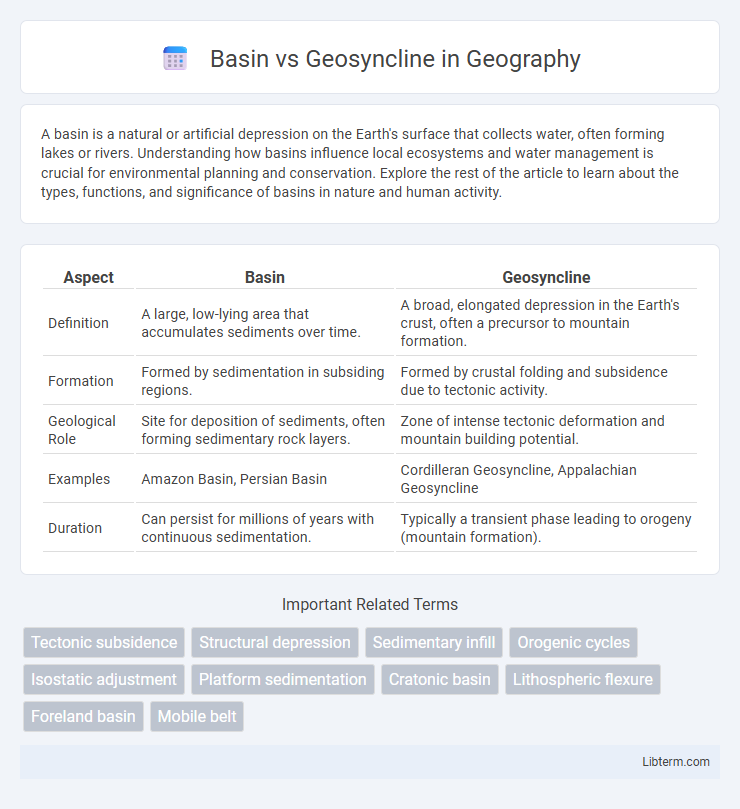A basin is a natural or artificial depression on the Earth's surface that collects water, often forming lakes or rivers. Understanding how basins influence local ecosystems and water management is crucial for environmental planning and conservation. Explore the rest of the article to learn about the types, functions, and significance of basins in nature and human activity.
Table of Comparison
| Aspect | Basin | Geosyncline |
|---|---|---|
| Definition | A large, low-lying area that accumulates sediments over time. | A broad, elongated depression in the Earth's crust, often a precursor to mountain formation. |
| Formation | Formed by sedimentation in subsiding regions. | Formed by crustal folding and subsidence due to tectonic activity. |
| Geological Role | Site for deposition of sediments, often forming sedimentary rock layers. | Zone of intense tectonic deformation and mountain building potential. |
| Examples | Amazon Basin, Persian Basin | Cordilleran Geosyncline, Appalachian Geosyncline |
| Duration | Can persist for millions of years with continuous sedimentation. | Typically a transient phase leading to orogeny (mountain formation). |
Introduction to Basin and Geosyncline
A basin is a large, low-lying area of the Earth's crust that collects sediments and water, often forming lakes or seas, and is characterized by subsidence and sediment accumulation. Geosynclines are extensive, elongated troughs in the Earth's crust associated with significant sediment accumulation and tectonic activity, representing early stages of mountain-building processes. Understanding the differences between basins and geosynclines is essential for interpreting geological structures and sedimentary environments.
Definition of Basin
A basin is a low-lying geological depression where sediments accumulate over time, often forming sedimentary rock layers. It contrasts with a geosyncline, which is a large-scale, elongated trough in the Earth's crust that experiences intense deformation and subsidence before mountain building. Basins play a crucial role in hydrocarbon accumulation and groundwater storage due to their sedimentary fill and structural characteristics.
Definition of Geosyncline
A geosyncline is a large-scale, elongated trough or depression in the Earth's crust that accumulates thick deposits of sediment over long geological periods, serving as a precursor to mountain formation through tectonic folding and uplift. Unlike a basin, which is generally a broader, more stable sedimentary area often filled with water or sediments, a geosyncline specifically refers to a dynamic structural feature involved in orogenic processes. Understanding the geosyncline concept is critical for studying the evolution of mountain belts and sedimentary basins in plate tectonics.
Key Differences Between Basin and Geosyncline
A basin is a low-lying area of the Earth's crust that collects sediment and often forms sedimentary rock layers, whereas a geosyncline is a large-scale structural depression where thick sequences of sediment accumulate and may undergo folding and deformation. Basins are typically stable and associated with sediment deposition, while geosynclines are dynamic regions linked to tectonic activities and orogenic processes. The key difference lies in their tectonic significance: basins serve primarily as sediment traps, whereas geosynclines are precursor zones to mountain building.
Formation Processes of Basins
Basins form primarily through subsidence caused by tectonic stretching, sediment loading, or thermal contraction, creating low-lying areas that accumulate sediments over time. Unlike geosynclines, which are large linear troughs associated with mountain-building and intense deformation, basins can form in various tectonic settings including rift zones, flexural depressions adjacent to orogenic belts, and pull-apart regions. Sediment infill within basins often reflects their ongoing subsidence rates and tectonic history, making basin formation a critical process in stratigraphic and structural geology.
Formation Processes of Geosynclines
Geosynclines form through the subsidence of large-scale linear troughs in the Earth's crust, accumulating thick sequences of sediments over millions of years. These depressions often develop in convergent plate boundaries where intense tectonic compression causes crustal thickening and downwarping. Unlike basins, which are typically formed by localized crustal extension or sagging, geosynclines represent dynamic zones of sedimentation preceding mountain building and orogenic activity.
Geological Significance of Basins
Basins are depressions in the Earth's crust that accumulate thick sequences of sedimentary rocks, playing a crucial role in hydrocarbon reservoir formation and groundwater storage. Unlike geosynclines, which are large-scale downwarps associated with mountain-building processes, basins provide stable environments for sediment deposition over extended geological periods. Their structural and stratigraphic characteristics are essential for understanding sedimentary processes and Earth's tectonic evolution.
Geological Importance of Geosynclines
Geosynclines are large-scale structural depressions in the Earth's crust that accumulate thick sequences of sedimentary and volcanic rocks, playing a crucial role in understanding mountain building and plate tectonics. These trough-like features are important for tracing the historical development of orogenic belts and the processes of Earth's crust deformation. Unlike basins, which are mainly sedimentary depressions, geosynclines represent dynamic zones linked to tectonic activity and lithospheric movements essential for reconstructing geological evolution.
Examples of Basins and Geosynclines Worldwide
The Michigan Basin in North America and the Paris Basin in Europe are prominent examples of sedimentary basins formed by subsidence and sediment accumulation. The Appalachian Geosyncline in the eastern United States and the Hercynian Geosyncline in Europe illustrate geosynclines characterized by extensive folding and mountain-building processes during tectonic plate convergence. These geological structures highlight distinct formation mechanisms and play crucial roles in hydrocarbon exploration and understanding earth's tectonic history.
Conclusion: Basin vs Geosyncline
Basin and geosyncline differ primarily in their geological formation and scale, with basins being smaller, stable depressions that accumulate sediments, while geosynclines represent large, long-lived structural troughs associated with mountain-building processes. Basins serve as important sedimentary environments influencing hydrocarbon accumulation, whereas geosynclines are crucial in understanding tectonic evolution and orogeny. Recognizing these distinctions helps in geological mapping, resource exploration, and interpreting Earth's structural history.
Basin Infographic

 libterm.com
libterm.com